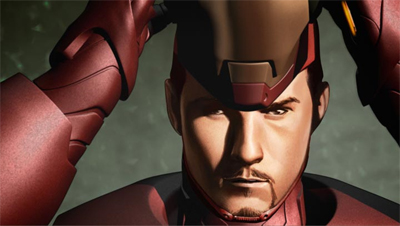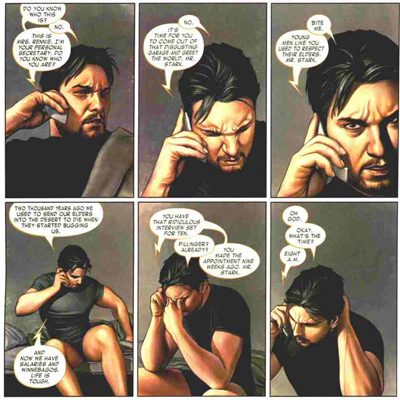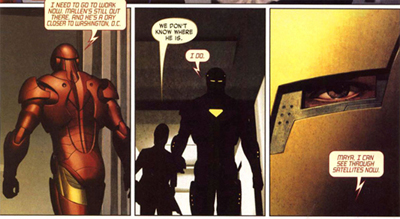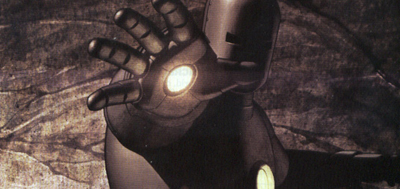John Pillinger says the Iron Man suit is a military application. I told him he was wrong. I’m trying to decide if I was lying. I’ve never sold any element of the Iron Man to the military. It’s used for extraordinary rescue and response situations. Iron Man saves lives. Iron Man used to represent the future.
– Tony Stark considers his legacy
What’s the Iron Man for, Tony?
– Sal cuts straight to the heart of the matter
The more Iron Man stories I read – and the more movies I see as well – it appears that Tony Stark as a lost individual isn’t a metaphor, it’s more of a metaphysical observation. He’s typically well written and carefully considered (of course, there are glaring exceptions), but he rarely seems to find himself involved in any particularly strong narratives. His appeal is centred entirely on the character’s charm, charisma and pride of place as one of fiction’s most famous and prestigious futurists. I don’t mean this as a slight on Extremis by any means – in fact, Warren Ellis’ revised mission statement for the true man of tomorrow may be the best Iron Man story I’ve read.
I found myself defending Matt Fraction’s run on The Invincible Iron Man as a thorough and considerate character study, while acknowledging that there wasn’t really anything spectacular going on plotwise. As charming as they were (and they were charming) Jon Favreau’s Iron Man and Iron Man 2 were relatively weak on the old plot front, requiring the charisma of the character and Robert Downey Jnr. to hold it all together. So I’m really not too surprised that Extremis is relatively light on plot. All you need to know is that domestic terrorists have gotten their grubby hands all over a top secret super soldier experiment – one that essentially ‘builds’ the man of tomorrow – and Tony Stark must stop them.
Over this somewhat sparse plot (which only exists to service Ellis’ themes and character study, not that there’s anything wrong with that), our author draws a picture of Tony Stark and – arguably to a greater extent – of Iron Man. In fact, the real focus of the miniseries is not Stark, though it does explore his own personal failures and the mistakes in his history (designing smart bombs and munitions chief amongst them, along with hints of his alcoholism and professional irresponsibility), but Iron Man – the series lays the most serious charges at the feet of the suit itself.
While Stark’s failures stem from bad choices and poor decisions, the suit is arguably even more guilty – it has done nothing. It has seemingly squandered its potential. Over the first two issues, in two absolutely fascinating conversations, Tony’s mentor and a left-wing documentary filmmaker both tear into Stark in order to explore his frequent claims of what the suit is or what the suit could be. He never really answers the question, because he’s not sure of the answer.
Ellis garnered a lot of attention for essentially rewriting the character’s origin, updating it to Afghanistan. It seems a logical step but, to be honest, it’s probably the least interesting aspect of the story. Due to the sheer mechanics of comic book time – where nobody really ages (for example, though he’s graduated high school and even college, Peter Parker is still only twenty-something nearly fifty years after his debut) – it seemed unavoidable that certain character origins would need to be updated.
Instead of the jungles of East Asia, Stark finds himself wounded by his own weaponry in Afghanistan. One imagines that in the next telling of his origin in a decade or so, he will find himself taken hostage in Iraq. However, these flashback segments are only really fascinating as they thematically tie into the story Ellis is attempting to tell here. Pay witness to Stark’s birth, Ellis suggests, so you may recognise his rebirth.
And that’s what this book is. It’s a rebirth. Not only in evolving the concept of human-and-machine interaction in a way that keeps the character at the cutting edge of futurism, but a mission statement for Stark and his ideas. Ellis skilfully and masterfully distills the essence of Tony Stark and (in particular) Iron Man into these pages. It’s ironic that the arc was drafted before Tony’s massive character derailment in Mark Millar’s Civil War (wherein the character became a pseudo-Nazi conscripting supervillains to hunt down his former friends who refused to publicly unmask and running an extra-dimensional prison camp where offenders were detained indefinitely without trial – and that’s not the worst of it). Here, Ellis offers us the image of a lost Tony Stark – adrift and confused.
Stark states in here that his nightmare is a version of himself who couldn’t see the future, but Ellis strongly implies that his nightmare isn’t an abstract fear: he’s feeling that pain and confusion right now. He can’t bear to look himself in the mirror and can’t even bother to offer half-hearted defenses of his company to those who attack it. Ellis instead manages to re-instill purpose in Stark and Iron Man. He gives him back the future.
It feels like a conscious mission statement by Ellis – a chance to lay out his agenda for his audience. However, one gets the sense that the vision never got to soar as it should. Here Ellis strips the character down to his basics – there’s none of the expansive supporting staff which arguably bogged down Jon Favreau’s big screen version of the character or turned Matt Fraction’s World’s Most Wanted into an over-indulgent story – and it works. There’s no real supervillain at play, no rival in an armour suit. There’s no showboating. There’s a hint of peril and some great action scenes, but you get the sense that Ellis was putting a few of his balls in play to be picked up on further down the line (the trouble brewing at Stark Industries, for example). I don’t know if Ellis was intended to have a longer run on the book, but the worst thing about Extremis is the sense that we won’t get to explore the beautiful future it promises for Tony. But that’s a minor complaint.
The influence of the book is obvious – particularly on the first motion picture. Ignoring the moving of Stark’s origin to Afghanistan, there’s more direct cues copied – most obviously the juggling of cars in a slugfest seems a set piece borrowed from this work. And although Stark’s legacy has always been a touchstone of the best stories about the character, the movie picks up tonally from Ellis’ exploration of the character as a repentant arms dealer. It just ‘fits’.
Adi Granov’s art is great. It takes some getting used to (it almost feels, appropriately enough, inorganic), but it suits the material well. There is the occasional ‘odd’ panel, but Granov captures the mood of the story well. In fact, at the risk of being harsh, it looks like this was the look that The Invincible Iron Man is attempting to emulate, just without a lot of success.
Extremis is a great story. It’s essentially an agenda for Iron Man, laid out in comic book form. Readers might be a bit surprised that two lengthy conversations on the nature of the suit (and the person wearing it) are the most fascinating aspects of the series, but that’s not a bad thing. The action is handled well (though it feels like it was shoehorned in because five issues of abstract philosophy may have been a bit much), however it’s the ideas which make this a solid read – and one of the best Iron Man stories out there.
Filed under: Comics | Tagged: adi granov, Comics, extremis, futurism, Guy Pearce, iron man, iron man: extremis, jon favreau, marvel, marvel comics, Movies, robert downey, Stark, tony stark, warren ellis |


























Leave a comment